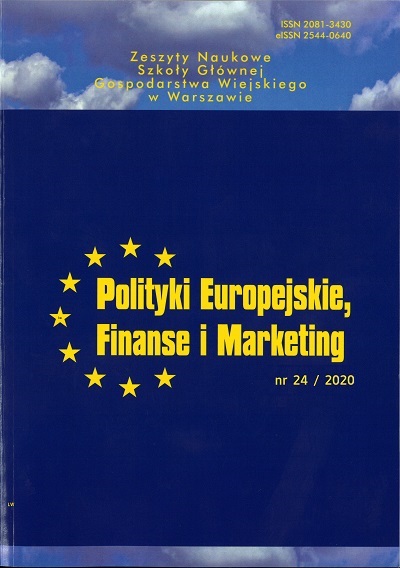Main Article Content
Article Details
Arias M. A., Wen Y.: The Liquidity Trap: An Alternative Explanation for Today's Low Inflation, The Regional Economist , 2014, April, https://www.stlouisfed.org/
Blanchard O., Cerutti E., Summers L.: Inflation and Activity - Two Explorations and their Monetary Policy Implications, IMF Working Paper, No 15/2015. (Crossref)
Frejtag-Mika E.: The dispute about ways out of the trap of liquidity and deflation. Acta Universitatis Lodziensis Folia Oeconomica, No 3 (303)/2014.
Friedman M.: The Role of Monetary Policy. American Economic Review, No 58 (1)/1968.
Hicks, J. R.: Mr. Keynes and the 'Classics', Econometrica, No 5 (2)/1937. (Crossref)
Keynes, J. M.: The General Theory of Employment, Interest, and Money, Macmillan, London 1936.
Krawczyk M.:. On fiscal and monetary policy in the conditions of the liquidity trap, Economist, No. 4/2013.
Krugman P. R.: It's Baaack: Japan's Slump and the Return of the Liquidity Trap, Brookings Papers on Economic Activity, No 29 (2)/1998. (Crossref)
Moe T. G., Marriner S.: Eccles and the 1951 Treasury - Federal Reserve Accord: Lessons for Central Bank Independence, Levy Economics Institute of Bard College Working Paper, No. 747/2013. (Crossref)
Nakata T., Schmidt S.: Expectations-driven liquidity traps: implications for monetary and fiscal Policy, ECB Working Paper Series, No 2304/2019. DOI: 10.17016 / FEDS. 2019.053 (Crossref)
Orphanides, A.:. The Fiscal-Monetary Policy Mix in the Euro Area - Challenges at the Zero Lower Bound. European Commission Discussion Paper No 060 , July 2017, 1-44. https://dx.doi.org/10.2139/ssrn.2965805 (Crossref)
"Money dropped from a helicopter" as an option of monetary policy, https://www. Obserwator finansowy.pl (14.10.2019).
Rosati DK (2016). New trends in monetary policy after the financial crisis 2008–2012, Finance, Financial Markets, Insurance, No. 4/2017. DOI: 10.18276 / frfu.2016.4.82 / 1-39. (Crossref)
Roubini N., Mihm S.: Economics of the crisis , Wolters Kluwer, Warsaw 2011.
Price stability - why is it also important for you? https://www.ecb.europa.eu/pub/pdf/other/whypricestability_en.pdf (30/04/2019).
Svensson L.O.: The Zero Bound in an Open Economy: A Foolproof Way of Escaping from a Liquidity Trap, Monetary and Economic Studies, No 19/2001. (Crossref)
Szymańska A.: Effects of fiscal policy at low interest rates - a review of the literature, Studies in Law and Economics, Volume XCIII/2014.
Thirion G.: European Fiscal Union: Economic Rationale and Design Challenges, CEPS Working Document, No 01/2017.
Tobin J.: Keynesian Models of Recession and Depression, American Economic Review Papers and Proceedings, No 65/1975.
Vandenbroucke F., Luigjes C., Wood D., Lievens K.:. Institutional Moral Hazard in the MultiTiered Regulation of Unemployment and Social Assistance Benefits and Activation - A Summary of Eight Country Case Studies, CEPS Special Report, No. 137/2016. (Crossref)
Downloads
- Wojciech Lichota, THE USE OF LOGISTIC MODELS TO DIAGNOSE THE RISK OF BANKRUPTCY IN ENTERPRISES , The Scientific Journal European Policies, Finance and Marketing: No. 24(73) (2020)
You may also start an advanced similarity search for this article.
- Piotr Misztal, COMMUNICATION OF THE CENTRAL BANK AS A DETERMINANT OF THE CREDIBILITY AND EFFECTIVENESS OF THE MONETARY POLICY ON THE EXAMPLE OF THE EUROPEAN CENTRAL BANK , The Scientific Journal European Policies, Finance and Marketing: No. 29(78) (2023)
- Piotr Misztal, THE HYPOTHESIS OF JOBLESS ECONOMIC GROWTH IN COUNTRIES WITH DIFFERENT LEVELS OF ECONOMIC DEVELOPMENT , The Scientific Journal European Policies, Finance and Marketing: No. 12(61) (2014)
- Piotr Misztal, Public debt and economic growth in the European Union countries , The Scientific Journal European Policies, Finance and Marketing: No. 5(54) (2011)
- Piotr Misztal, Marcin Łupiński, ARE POLISH BANKS STABLE? A SYSTEMIC RISK ANALYSIS , The Scientific Journal European Policies, Finance and Marketing: No. 27(76) (2022)

This work is licensed under a Creative Commons Attribution-NonCommercial 4.0 International License.
All articles published in European Policies, Finance and Marketing are fully open access. In this way, the scientific research results contained in articles published in our journal are available to every reader free of charge - in accordance with the CC BY-NC license (https://creativecommons.org/licenses/by-nc/4.0/).
According to the CC BY-NC license you are free to:
- Share — copy and redistribute the material in any medium or format
- Adapt — remix, transform, and build upon the material
The licensor cannot revoke these freedoms as long as you follow the license terms.
Under the following terms:
- Attribution — You must give appropriate credit , provide a link to the license, and indicate if changes were made . You may do so in any reasonable manner, but not in any way that suggests the licensor endorses you or your use.
- NonCommercial — You may not use the material for commercial purposes .
- No additional restrictions — You may not apply legal terms or technological measures that legally restrict others from doing anything the license permits.
Source: https://creativecommons.org/licenses/by-nc/4.0/deed.en
According to that, the authors retain the copyright and full publishing rights.





